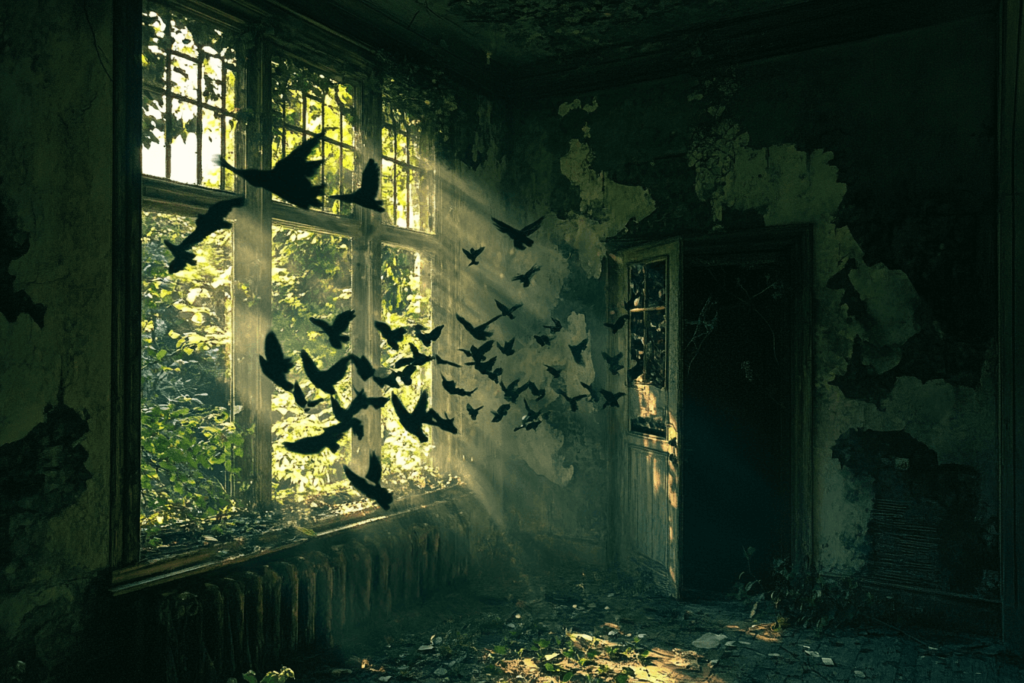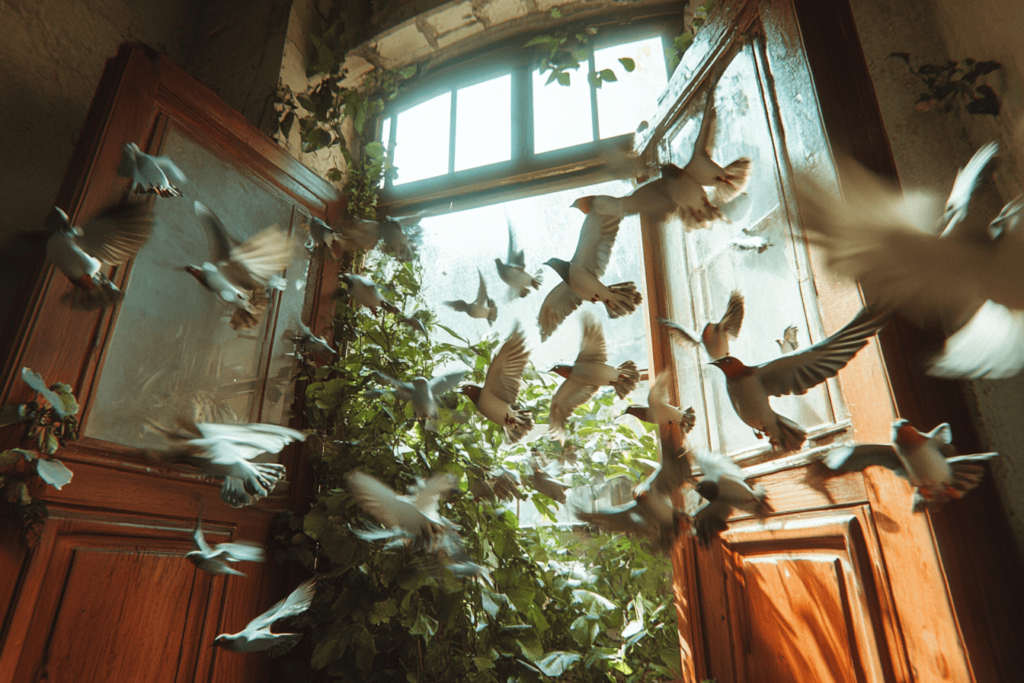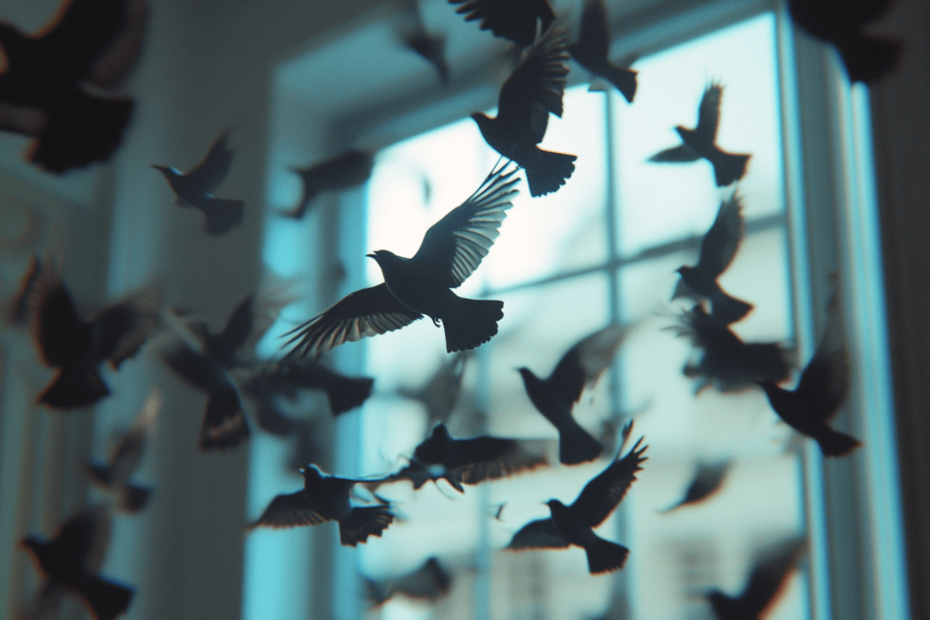Introduction
As someone who has lived in a rural area for over two decades and encountered numerous incidents of birds flying into my house, I’ve become somewhat of an expert on this topic. From startled sparrows to persistent pigeons, I’ve seen it all. In this comprehensive guide, I’ll share my first-hand experiences and the knowledge I’ve gained over the years about dealing with birds flying into houses.
Birds Flying Into the House
The first time a bird flew into my house, I was caught completely off guard. It was a warm spring afternoon, and I had left the patio door open to enjoy the breeze. Suddenly, a flash of feathers zipped past me, and I found myself with an unexpected avian guest. This incident sparked my curiosity about why birds enter our homes in the first place.
Accidental Entry
In my experience, most cases of birds flying into houses are purely accidental. Birds, especially smaller species like sparrows and finches, can easily become disoriented when flying at high speeds. They might see reflections in windows or simply not register the glass as a solid barrier. I’ve had countless instances where birds have flown into my large living room windows, thinking they were heading towards open sky or trees.
Seeking Shelter or Nesting Sites
Over the years, I’ve noticed that birds are more likely to enter homes during certain seasons, particularly in spring and early summer. This coincides with their nesting season. In one memorable instance, a pair of robins attempted to build a nest in my garage rafters. They would repeatedly fly in whenever the garage door was open, carrying twigs and grass in their beaks.
Attraction to Indoor Environments
Sometimes, birds are attracted to the inside of our homes. I’ve found that this is often due to:
- Food sources: If you have indoor plants or fruit bowls visible from outside, birds might be tempted to investigate.
- Warmth: During cold spells, birds might seek the warmth they can sense from our heated homes.
- Curiosity: Some bird species, like crows and magpies, are naturally curious and might enter out of sheer inquisitiveness.
Common Bird Species Prone to Entering Houses
In my area, the most common uninvited avian guests have been:
- Sparrows
- Robins
- Pigeons
- Starlings
- Swallows
Each species presents its own challenges when it comes to removal and prevention, which I’ll discuss later in this article.
Potential Risks and Concerns
Having a bird in your house isn’t just a minor inconvenience. Over the years, I’ve learned that it can pose several risks and concerns that need to be addressed promptly.
For the Bird’s Safety
The safety of the bird is always my primary concern when one flies into my house. Birds can easily injure themselves in an unfamiliar indoor environment. I’ve seen birds fly into windows repeatedly in their panic to escape, sometimes resulting in concussions or even fatal injuries. Sharp edges on furniture or decor can also pose a danger to a frantically flying bird.
For Human Health and Hygiene
While I love birds, I’m also aware of the potential health risks they can bring into a home. Birds can carry various diseases, some of which can be transmitted to humans. The most common concerns include:
- Salmonella
- E. coli
- Histoplasmosis (from bird droppings)
- Cryptococcosis
Additionally, birds can bring in parasites like mites or ticks. After any incident of a bird in the house, I always do a thorough cleaning to mitigate these risks.
Birds Flying Into the House: Damage to Property
In my experience, a panicked bird can cause surprising amounts of damage in a short time. I’ve had birds knock over vases, scratch furniture, and even leave droppings on upholstery. One particularly memorable incident involved a starling that managed to upturn a potted plant, spreading soil across my white carpet!

Legal Considerations (Protected Species)
It’s crucial to be aware that many bird species are protected by law. In the United States, the Migratory Bird Treaty Act protects most native bird species. This means that harming these birds, even unintentionally, can result in legal consequences. I always make sure to handle birds with care and contact local wildlife authorities if I’m unsure about how to proceed with a protected species.
Prevention: Keeping Birds from Flying Into Your House
After dealing with several bird incidents, I’ve learned that prevention is key. Here are some strategies I’ve implemented successfully:
Securing Entry Points
The most effective way to prevent birds from flying into your house is to secure all potential entry points. In my home, I’ve:
- Installed screens on all windows and doors that I frequently leave open.
- Repaired any holes in the roof or siding where birds might enter.
- Used chimney caps to prevent birds from nesting in or falling down the chimney.
Using Visual Deterrents
Visual deterrents have been surprisingly effective in my experience. Some methods I’ve used include:
- Window decals: These break up reflections and make glass more visible to birds.
- Hanging shiny objects: CDs or aluminum pie plates near entry points can deter birds.
- Predator decoys: I’ve placed a plastic owl on my porch, which has significantly reduced bird activity near the house.
Managing Outdoor Attractants
I’ve found that managing what attracts birds to your property in the first place can help reduce the likelihood of them entering your home. Some steps I’ve taken include:
- Moving bird feeders and baths further away from the house
- Keeping garbage cans sealed to prevent birds from scavenging
- Trimming trees and shrubs near the house to reduce perching spots
Seasonal Considerations
I’ve noticed that bird activity around my house changes with the seasons. In spring and early summer, when birds are nesting, I’m extra vigilant about keeping doors and windows closed or screened. In fall, when many birds are migrating, I make sure to keep my curtains closed at night to avoid confusing birds with indoor lights.
Birds Flying Into the House What to Do?
Despite our best prevention efforts, sometimes birds still find their way inside. Over the years, I’ve developed a systematic approach to handle these situations calmly and effectively.
Staying Calm and Assessing the Situation
The first time a bird flew into my house, I panicked, which only made the situation worse. Now, I know that staying calm is crucial. When a bird enters, I take a moment to:
- Identify the bird species if possible
- Note which room the bird is in
- Observe if the bird appears injured
- Ensure all family members and pets are out of the room
Creating an Exit Path
My go-to strategy is to create a clear path for the bird to exit on its own. This usually involves:
- Closing off other rooms to contain the bird in one area
- Opening windows and doors in that room
- Removing obstacles between the bird and the exit
- Turning off any ceiling fans to prevent injury
Using Gentle Capture Methods
If the bird doesn’t find its way out on its own, I sometimes need to intervene. I’ve found the following methods to be effective and humane:
- The Sheet Method: Gently tossing a light sheet over the bird to calm it, then carefully gathering it up and releasing it outside.
- The Box Method: Using a cardboard box to gently “scoop” up the bird, then covering the box and releasing it outdoors.
When to Call for Professional Help
There have been times when I’ve had to admit defeat and call for professional help. This is usually in cases where:
- The bird is injured
- It’s a protected species that requires special handling
- The bird is in a hard-to-reach place (like inside a chimney)
I keep the number of a local wildlife rehabilitator handy for these situations.
Safe Removal Techniques
Over the years, I’ve refined my techniques for safely removing birds from my house. Here are some methods I’ve found most effective:
The Towel Method
This is my go-to method for smaller birds. Here’s how I do it:
- I approach the bird slowly with a light towel held out in front of me.
- When close enough, I gently drape the towel over the bird.
- I carefully gather the towel around the bird, being mindful not to apply too much pressure.
- I take the bundled towel outside and gently release the bird.
I’ve found this method to be particularly effective with sparrows and finches, which are common visitors to my home.
Using a Cardboard Box
For slightly larger birds, I prefer the cardboard box method:
- I take a medium-sized box and remove the top.
- I approach the bird slowly, holding the box in front of me.
- When I’m close enough, I quickly place the box over the bird.
- I slide a piece of cardboard under the box to create a temporary bottom.
- I carry the box outside and release the bird by tipping the box on its side.
This method worked wonderfully when I had a pigeon fly into my kitchen last summer.
Dimming Lights and Opening Windows
Sometimes, the simplest methods are the most effective. I’ve had success with this technique:
- I turn off all indoor lights and close curtains to make the room dark.
- I open windows or doors wide, removing screens if necessary.
- I leave the room and wait quietly.
Often, the bird will naturally fly towards the light coming from outside and find its way out.

Avoiding Common Mistakes
Through trial and error, I’ve learned what not to do when trying to remove a bird:
- Don’t chase the bird: This only increases its panic and can lead to injury.
- Avoid loud noises: Sudden sounds can startle the bird and make it harder to catch.
- Don’t use food as bait: This can encourage the bird to return in the future.
After the Bird Has Left: Next Steps
Once the bird is safely out of my house, my work isn’t done. There are several important steps I always take:
Cleaning and Disinfecting
Given the potential health risks associated with birds, I always do a thorough cleaning:
- I clean any droppings immediately with a disinfectant.
- I wash any fabrics the bird may have come into contact with.
- I vacuum and mop the affected areas.
- I air out the room by opening windows.
Checking for and Repairing Damage
Birds can cause surprising amounts of damage in a short time. After each incident, I do a careful inspection:
- Check windows for cracks or chips
- Look for scratches on furniture or walls
- Inspect houseplants for damage
- Check for any items that may have been knocked over and broken
I once had a starling knock over an antique vase, so I learned the hard way to be thorough in these checks!
Reinforcing Prevention Methods
Each bird incident is a learning opportunity. After removing a bird, I always reassess my prevention methods:
- I check all screens for tears or loose fittings.
- I reassess the placement of bird feeders and baths in my yard.
- I consider adding additional visual deterrents to problem areas.
By continuously improving my prevention strategies, I’ve significantly reduced the frequency of birds entering my home.
Special Scenarios
Over the years, I’ve encountered some unique situations that required special handling. Here are a few memorable incidents and how I dealt with them:
Dealing with Injured Birds
One spring morning, I found a robin that had flown into my living room window and appeared stunned. Here’s what I did:
- I gently placed the bird in a cardboard box lined with a soft towel.
- I kept the box in a quiet, dark place.
- I contacted a local wildlife rehabilitator for advice.
- Under their guidance, I monitored the bird for a few hours until it recovered and could be released.
This experience taught me the importance of having a wildlife expert’s contact information on hand.
Nesting Birds in the House
Last year, a pair of barn swallows managed to build a nest in my garage rafters before I noticed. Dealing with this situation required patience and care:
- I consulted with a local bird expert to ensure I wasn’t violating any wildlife protection laws.
- I waited until the young birds had fledged before removing the nest.
- I thoroughly cleaned the area and installed barriers to prevent future nesting.
This experience highlighted the importance of regular checks of attics, garages, and other less-frequented areas of the house.
Repeated Incidents with the Same Bird
One summer, I had a persistent cardinal that kept trying to fly into my home office window. To solve this unusual problem:
- I identified that the bird was seeing its reflection and trying to defend its territory.
- I installed external screens on the windows to break up the reflection.
- I placed decoy predators (like a plastic owl) near the window.
These measures finally discouraged the cardinal from its repeated attempts to enter.
Large or Aggressive Bird Species
While most of my experiences have been with smaller birds, I once had a crow fly into my kitchen. This larger, more intelligent bird presented unique challenges:
- I cleared the room of people and pets to reduce stress on the bird.
- I opened all possible exits and dimmed the lights.
- I used a broom to gently guide the bird towards the open door.
This incident taught me the importance of staying calm and patient, even with larger or more intimidating bird species.
Cultural and Superstitious Beliefs About Birds in Houses
Throughout my experiences with birds entering my home, I’ve heard various cultural interpretations of these events. While I approach these situations from a practical standpoint, I find the cultural aspects fascinating.
Various Cultural Interpretations
Different cultures view birds entering houses in various ways:
- In some European traditions, a bird flying into a house is seen as a sign of impending death.
- In Native American cultures, certain birds entering a home might be viewed as spirit messengers.
- In Chinese culture, a bird flying into a house can be seen as a positive omen, signifying an opportunity coming your way.
Scientific Perspective on These Beliefs
As someone who has dealt with numerous bird incidents, I can confidently say that birds enter houses for practical reasons rather than supernatural ones. However, I respect that these beliefs can provide comfort or meaning to some people.
From a scientific standpoint, birds enter houses due to:
- Confusion caused by reflective surfaces
- Attraction to indoor environments (food, warmth, etc.)
- Accidental entry while in flight
Understanding these factors has helped me approach bird incidents with a calm, rational mindset.

Frequently Asked Questions About Birds Flying Into Houses
Over the years, I’ve been asked many questions about my experiences with birds entering my home. Here are some of the most common ones:
If a bird flies into your home, is it unlucky?
While many cultures have superstitions about this, from my experience, a bird flying into your house is simply an accident. It’s not a sign of good or bad luck, just a natural occurrence that can happen when wildlife and human habitats intersect.
Can birds carry diseases into your home?
Yes, birds can potentially carry diseases. In my experience, the risk is generally low if you handle the situation properly. Always clean and disinfect any areas the bird has been in, and avoid direct contact with the bird or its droppings.
What time of year are birds most likely to fly into houses?
In my experience, spring and early summer see the most incidents. This coincides with the nesting season when birds are more active and may be seeking nesting sites. I’ve also noticed an increase during fall migration periods.
How do I bird-proof my chimney?
To bird-proof a chimney:
- Install a chimney cap with mesh sides
- Check for and repair any damage to the chimney structure
- Have your chimney professionally cleaned and inspected annually
I had a chimney cap installed after finding a nest in my chimney, and it’s been effective in preventing further incidents.
Conclusion
Dealing with birds flying into the house has been a journey of learning and adaptation for me. Each incident has taught me something new about bird behavior, home maintenance, and the delicate balance between human habitats and wildlife.
Key takeaways from my experiences include:
- Prevention is the best strategy. Secure entry points and manage outdoor attractants.
- Stay calm when a bird enters your home. Panic only makes the situation worse.
- Use gentle, humane methods to remove birds when necessary.
- Always prioritize the safety of both the bird and yourself.
- Clean and disinfect thoroughly after any bird incident.
- Continuously reassess and improve your prevention methods.
Remember, while it can be startling to have a bird fly into your house, with the right approach, you can handle the situation safely and compassionately. These encounters, while sometimes challenging, have given me a deeper appreciation for the wildlife around us and the importance of coexisting harmoniously with nature.
